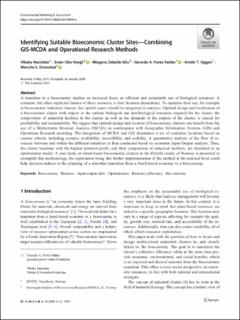| dc.contributor.author | Nørstebø, Vibeke Stærkebye | |
| dc.contributor.author | Krøgli, Svein Olav | |
| dc.contributor.author | Debella-Gilo, Misganu | |
| dc.contributor.author | Valdes, Gerardo Alfredo Perez | |
| dc.contributor.author | Uggen, Kristin Tolstad | |
| dc.contributor.author | Dramstad, Wenche | |
| dc.date.accessioned | 2020-08-24T12:46:28Z | |
| dc.date.available | 2020-08-24T12:46:28Z | |
| dc.date.created | 2020-02-17T13:17:51Z | |
| dc.date.issued | 2020 | |
| dc.identifier.citation | Environmental Modelling and Assessment. 2020, . | en_US |
| dc.identifier.issn | 1420-2026 | |
| dc.identifier.uri | https://hdl.handle.net/11250/2673675 | |
| dc.description.abstract | A transition to a bioeconomy implies an increased focus on efficient and sustainable use of biological resources. A common, but often neglected feature of these resources is their location dependence. To optimize their use, for example in bioeconomic industrial clusters, this spatial aspect should be integrated in analyses. Optimal design and localization of a bioeconomic cluster with respect to the various biological and non-biological resources required for the cluster, the composition of industrial facilities in the cluster, as well as the demands of the outputs of the cluster, is crucial for profitability and sustainability. We suggest that optimal design and location of bioeconomic clusters can benefit from the use of a Multicriteria Decision Analysis (MCDA) in combination with Geographic Information Systems (GIS) and Operations Research modeling. The integration of MCDA and GIS determines a set of candidate locations based on various criteria, including resource availability, accessibility, and usability. A quantitative analysis of the flow of resources between and within the different industries is then conducted based on economic Input-Output analysis. Then, the cluster locations with the highest potential profit, and their composition of industrial facilities, are identified in an optimization model. A case study on forest-based bioeconomic clusters in the Østfold county of Norway is presented to exemplify this methodology, the expectation being that further implementation of the method at the national level could help decision makers in the planning of a smoother transition from a fossil-based economy to a bioeconomy. | en_US |
| dc.language.iso | eng | en_US |
| dc.publisher | Springer | |
| dc.rights | CC BY 4.0 | * |
| dc.rights.uri | http://creativecommons.org/licenses/by/4.0/ | * |
| dc.subject | Bioeconomy | en_US |
| dc.subject | Bioeconomy | en_US |
| dc.subject | Biomassetilgang | en_US |
| dc.subject | Biomass access | en_US |
| dc.subject | Klynger | en_US |
| dc.subject | Clusters | en_US |
| dc.subject | Optimering | en_US |
| dc.subject | Optimization | en_US |
| dc.subject | GIS-modeller | en_US |
| dc.subject | GIS models | en_US |
| dc.subject | Input-Output analyse | en_US |
| dc.subject | Input-Output Analysis | en_US |
| dc.title | Identifying Suitable Bioeconomic Cluster Sites—Combining GIS-MCDA and Operational Research Methods | en_US |
| dc.type | Peer reviewed | en_US |
| dc.type | Journal article | en_US |
| dc.description.version | publishedVersion | en_US |
| dc.rights.holder | © 2020 The authors | en_US |
| dc.source.pagenumber | 15 | en_US |
| dc.source.journal | Environmental Modelling and Assessment | en_US |
| dc.identifier.doi | 10.1007/s10666-020-09694-x | |
| dc.identifier.cristin | 1794780 | |
| dc.relation.project | Norges forskningsråd: 244608 | en_US |
| cristin.ispublished | true | |
| cristin.fulltext | original | |
| cristin.qualitycode | 1 | |

